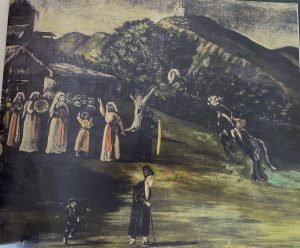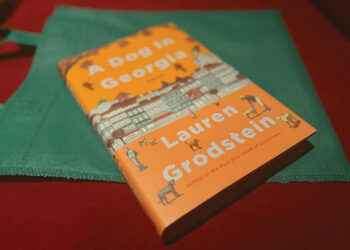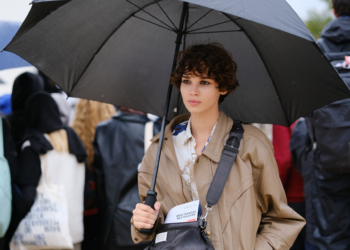The High Yellow Note is a quotation of Van Gogh that inspired curator Bice Curiger for her next exhibition at the Fondation Vincent van Gogh Arles. She emphasized that through this “high yellow note,” Van Gogh was “able to attend… [it] is not about yellow paintings, it‘s about the attitude and it’s about expressionism which is not inside but in the outer realm; it’s all about emotion.” We met Bice Curiger for an interview during the Berlin Art Week on the occasion of the exhibition curated by her at the Schinkel Pavillon dedicated to the work of German artist Sigmar Polke.
The title of the exhibition is Sigmar Polke. The Native Forest Floor. Higher Powers Command: Show Polke! It should be understood both figuratively and literally, ironically referring to the breeding ground of the artist’s biography, which was so intertwined with that of both post-war Germanies. “The Higher Powers” on the other hand, is Polke’s ironic and critical allusion to symbols of artistic inspiration like muses or else and the common tendency to exaggerate some abstract creative forces that one vaguely perceives but believes to be of higher influence or destination.
Known for his eclectic and experimental approach to painting and media, Polke’s artistic style is marked by a blending of high and low culture, often incorporating irony and satire. Polke’s works challenged traditional boundaries, embracing what he coined as “Capitalist Realism”—a critique of consumerism and mass culture, paralleling the Western pop art movement while addressing post-WWII German identity. Polke frequently employed a mix of unconventional materials like printed fabrics; objects attached to the medial surface, creating layered, abstract compositions that evoke a sense of visual playfulness while often confronting serious social and political themes. His use of raster dots, reminiscent of commercial printing, and his manipulation of photographic imagery lent his work a distinctive fusion of painterly gesture and mechanized reproduction, highlighting the fluidity between image and reality.
As Bice Curiger writes in her book Sigmar Polke. Alles Fließt: Die Photo Copie GmbH, while observing his works, the eye “concentrates either on the image as a whole, or on the singular details, the raster dots… that mark the boundary between something and nothing… Here also come up the ‘misprints’ as a motive.”
One witnesses the “atomization of the images… a radicalization of material and visual nature. It is the introduction of free particles, pigments and lacquer, it is the inclusion of up to now untouched micro-and macro universes.” Not only the innovative raster dot painting style but undoubtedly Polke’s signature wit attracts the viewers of all generations up to now: e.g. the painting Gangster, 1988, represents the artist in underpants wide opening his coat, the inside of which is filled with robbed trophies on offer and indulging the onlookers in voyeuristic instincts, here as in painting it’s all about seeing and making visible. Likewise in Carl Andre in Delft, 1968, the art-historical references of Polke to the visual imagery of the Delft tiles rendered by the artist in intricate hand-painted patterns in cobalt blue on a white background all arranged in a Carl Andre signature grid structure emphasizes the contradiction between the minimalist, geometric forms of tiles arranged in grid-like patterns against the flowing decor ornaments characteristic for the Delft tiles.
Besides important paintings such as Carl Andre in Delft, 1968, Die Schmiede (Smithy), 1975, Gangster, 1988, Flüchtende, 1992; or the later pigment painting Lapislazuli, 1992, a collection of photographs from the 1960s/70s—the majority of which are in fact unique—are being shown at Schinkel Pavillon for the very first time. They in particular give a fascinating insight into the vibrancy of the youth movement of the time, and the fundamental unmooring of the German post-war status quo it set in motion. In Dr. Bonn, 1978, a civil servant sits in front of his desk with his face obliterated, about to commit suicide using a slingshot. On the wall in front of him hang the striking mugshots of two RAF (Red Army Faction) members. Sicherheitsverwahrung, 1979, captures the arrest of a woman in the style of a comic strip. Approaching the canvas one then recognizes that it is adorned with fine gold chains, safety pins and trinkets.
Bice Curiger, who knew Sigmar Polke personally emphasized that the term Capitalist Realism coined by Polke is still excessively relevant for contemporary societies and that the artist who was famous for his tongue-in-cheek wit used to analyze the evils of society and injustices that were inherent in the so-called “Heimische Waldboden” (home forest floor) contaminated by consumerism of the post-war era after all the atrocities of the Nazi rule and the Second World War devastations.
For her as a curator art is something that reveals the unseen, discovers, brings to light and illuminates. Therefore the choice of the title ILLUMInations for the 54th Venice Biennale that she curated in 2011. It was not so much about “nations” but more about illuminating those blinded by nation-driven craze. As she emphasized art “has to do with experiences we share – nation as a community, ILLUMInations of artistic community – an ideal that has to be protected and that we can debate more freely in the politics or in the every day life relationships”

Bice Curiger was one of the first curators who discovered for the Western art world the works of iconic Georgian painter Niko Pirosmani and exhibited them in Kunsthaus Zürich back in 1995.
According to her recollections “it all started with AICA art critics association meeting in 1989 Leningrad and due to food shortages the conference was moved to Tbilisi where she first saw Pirosmani’s paintings in the State Museum. She was so impressed by the authenticity of Pirosmani’s paintings that she looked for his catalogue raisonné when she was back in Zurich in a Communist bookshop. The Exhibition in Kunsthaus Zürich was called “Signs of Wonder. Niko Pirosmani and the Contemporary Art” and along with paintings by Pirosmani included works by Cindy Sherman, Mike Kelly, Jeff Koons, Katarina Fritsch.
“I wanted to create 6 chapels where I included in each chapel the works of Pirosmani in the middle of the exhibition space 70 m long and 80 m wide where you put architecture,” she tells us. “We had to negotiate it all with the director in Tbilisi, the works arrived accompanied by Jonni Akhobadze, he took care of them and the museum invited him to stay a week or two to learn new techniques of restoration and the Kunsthaus then bought a computer and some instruments for restoration that we offered to the museum (in Tbilisi).
“The exhibition idea was: here’s a young generation of artists who aren’t minimal artists, not abstract artists but trying to have certain directness in their artistic language like Pirosmani, who was painting to attract immediate attention, in the dark tavernas speaking and reaching out to public looking for directness, and that was the nominator to bring these together.
“I wanted to put him into the context of contemporary art, something that has fallen down from the sky and you don’t really know, to take him away from the label of naive artists. Because “naive” is already looking down at someone who has no education and this is already the wrong approach. To put him on the same level as contemporary artists was a very important aspect of the exhibition. And then you tell the story, where it is coming from, you tell his biography and we showed the films which are beautiful films, it’s always more the question of the context…”
Like any artist whose creativity is based on sincerity and profound observation of reality Pirosmani’s work is as relevant for us today as back in the twenties when he was rediscovered by the Zdanevich brothers, in 1995 within the context of contemporary artists of the time in Kunsthaus Zürich as well as now with our societies. His archaic almost archetypal imagery is stylized and his protagonists are set in rural or urban contexts with almost theatrical postures, yet their directness and immediacy appeals to the hearts of the viewers.
Maybe “the perspectives in the landscapes are not rendered according to the classical laws of composition,” as art critic Alexander Kamensky points out in the introduction to Niko Pirosmani catalogue, but the “feeling is rendered unmistakably and the emotion is flawlessly true.”
The flatness of the paintings emphasizes the medial surface, the wax cloth on which color pigments are applied in brisk brushstrokes and the process of painting becomes a means of rendering reality captured by Pirosmani in a poetic way transforming and sublimating every-day genre scenes and human gatherings during harvests, feasts, hunting, fishing or else into timeless rituals of celebration of togetherness, humanity and nature.
According to Bice Curiger who wrote about the artist in ‘Niko Pirosmani. Wanderer between Worlds’: his “plasticity results from skillfully employed smearing of the paint, which caused the background to shine through, or by using the black as the contour line: for example in “Nurse with a Child” where the painter left the black of the ground exposed around the figure of the baby. Dark line contours stand in contrast to the reduced palette of colors: fresh white, pale pink and bright blue…fairy-tale atmospheres filled with secrets waft around many of Pirosmani’s paintings. But we are by no means looking into an unreal world; on the contrary we are participating in a shared more profound recognition.”
Recently as a contemporary ongoing homage to Pirosmani, Ciprian Adrian Barsan initiated the Table Project supported by artists. Some of the participants have been Tadao Ando, who designed a table, Andro Wekua, Adrain Ghenie and Georg Baselitz who made respectively portraits of Niko Pirosmani, Kiki Smith and other artists. The idea goes back to Pirosmani himself whose dream has been to buy a house in the center of Tbilisi with a samowar on a big table around which artists irrespective of nationality, gender, age or class belonging would meet up, drink tea and discuss art. This wish sadly never came true in Pirosmani’s lifetime, but hopefully now, a hundred year later contemporary discussions and dialogues on art would inspire artists of today leading some of them “to attend” this vague and mysterious, unattainable “yellow note,” something exceeding one’s capacities and requiring an artist to go beyond in search of artistic expression to explore the new boundaries, probably something outwardly and hardly attainable, that any painter reaches for in the constant search during the creative process but very few manage to achieve.
The exhibition Der heimische Waldboden. Höhere Wesen befahlen: Polke zeigen! is curated by Bice Curiger, it was initiated and organized by Schinkel Pavillon and will be on display at the Fondation Vincent van Gogh Arles from 1 March until 19 October, 2025. Bice Curiger is the Artistic Director of Fondation Vincent van Gogh Arles, editor of the Parkett Art Magazine and among others curator of the 54th Venice Biennale that took place in 2011. Exhibition The High Yellow Note will take place at Fondation Vincent van Gogh Arles between 5 Oct. 2024 -9 Feb. 2025
By Lily Fürstenow
Watch the full interview with Bice Curiger and Lily Fürstenow on youtube:














